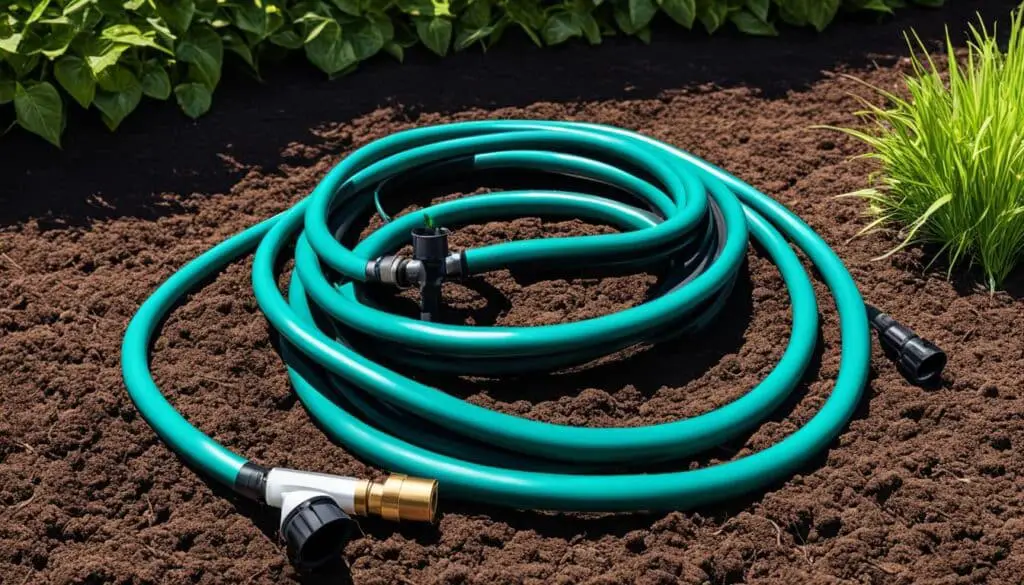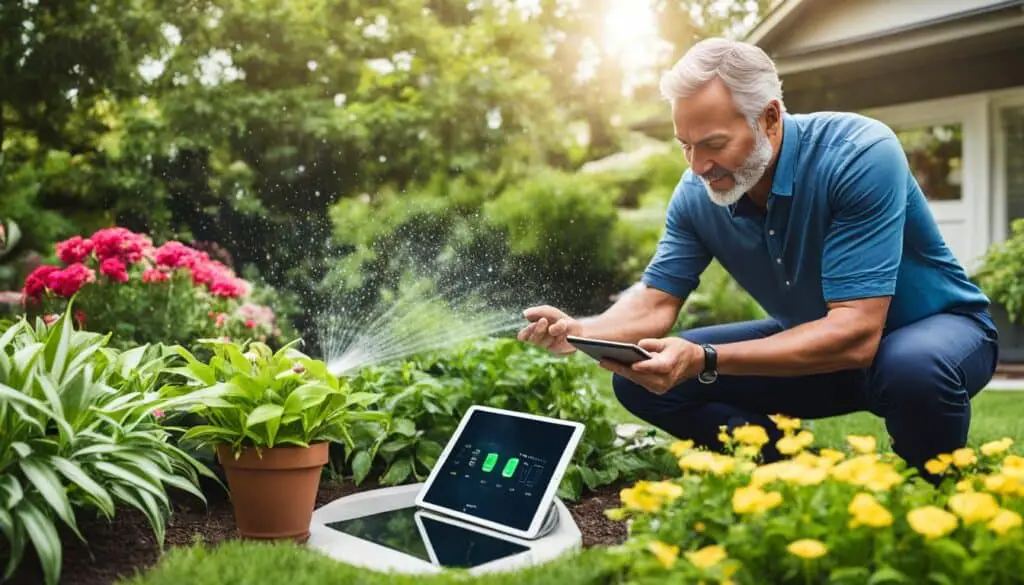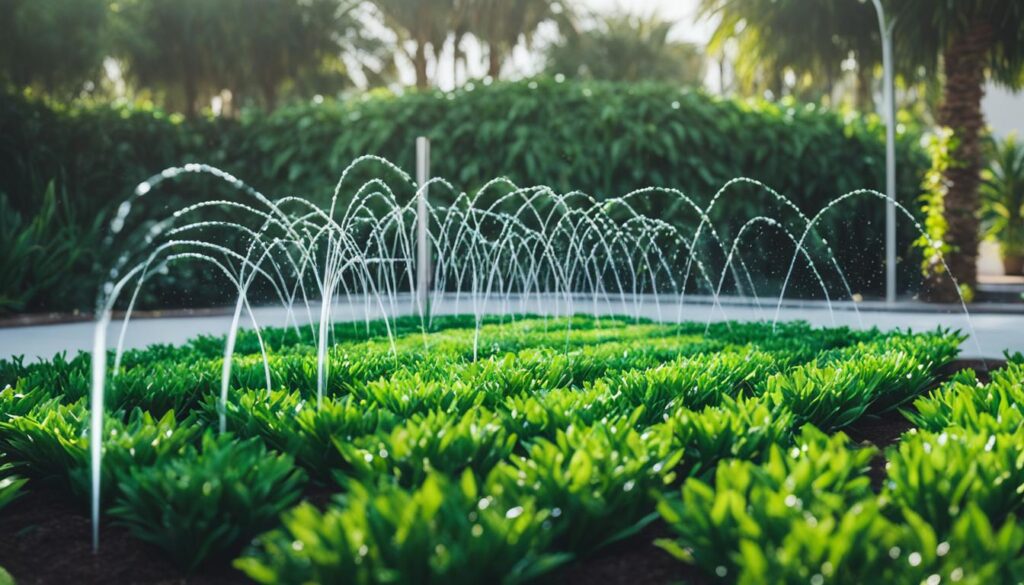Hello, fellow garden enthusiasts! Are you ready to take your gardening game to the next level? Today, I’m going to show you how to set up a smart irrigation system for your water-wise garden, even if you’re a beginner like me.
Setting up a smart irrigation system can revolutionize the way you water your plants. Not only will it ensure that your plants receive the perfect amount of water, but it will also help you conserve water and reduce your effort. Let’s dive in and get started!
Table of Contents
Key Takeaways:
- Setting up a smart irrigation system is a great way to conserve water while ensuring your plants thrive.
- Even beginners can easily learn how to install and use a smart irrigation system.
- A smart irrigation system adjusts watering schedules based on specific plant needs and weather conditions.
- Choosing the right system and programming it correctly are key to maximizing water efficiency.
- Regular monitoring and maintenance are important for the smooth operation of your smart irrigation system.
Why Use Smart Irrigation Systems?
Smart irrigation systems offer a multitude of benefits, making them a valuable addition to any garden. These advanced systems utilize sensors and weather data to optimize watering schedules based on the specific needs of your plants and prevailing weather conditions. The result? Your plants receive the ideal amount of water without any wastage. Here’s why incorporating smart irrigation systems can revolutionize your gardening:
- Water Conservation: With smart irrigation systems, water conservation becomes effortless. By precisely tailoring water delivery to match your plants’ requirements, these systems eliminate the risk of overwatering and ensure no water goes to waste. This not only helps protect our precious water resources but also reduces water bills.
- Efficiency: Smart irrigation systems are designed for efficiency. By utilizing real-time data on weather patterns and plant moisture levels, they optimize the timing and quantity of water applied. This maximizes the effectiveness of watering while minimizing the need for manual adjustments and guesswork.
- Environmental Friendliness: By promoting precise irrigation practices, smart systems contribute to sustainable and eco-friendly gardening. Conserving water reduces the strain on natural water sources, and efficient watering practices minimize run-off and soil erosion. In this way, smart irrigation systems help protect and preserve our environment for future generations.
Investing in a smart irrigation system is not just a smart choice – it’s also a smart way to cultivate healthier gardens and promote responsible water usage. By harnessing technology to optimize watering practices, you’ll enjoy lush, thriving plants while making a positive impact on the environment.
To visually illustrate the impact of smart irrigation systems, refer to the following table:
| Benefit | Description |
|---|---|
| Water Conservation | Optimizes water usage, prevents overwatering, and reduces water bills. |
| Efficiency | Adjusts watering schedules based on weather conditions and plants’ needs, allowing for precise and effective irrigation. |
| Environmental Friendliness | Promotes sustainable gardening by minimizing water waste and protecting natural resources. |
By leveraging the power of smart irrigation systems in your garden, you can conserve water, enhance efficiency, and contribute to a greener future.
Choosing the Right Smart Irrigation System
When it comes to selecting a smart irrigation system for your garden, there are several important factors to consider. By taking into account these key considerations, you can choose a system that best suits your needs, ensuring efficient water usage and optimal plant health. Let’s explore the factors that should influence your decision-making process.
Factors to Consider
- Size of your garden: The size of your garden plays a crucial role in determining the type of smart irrigation system you need. Smaller gardens may require a simpler system, whereas larger gardens might benefit from more advanced solutions. Consider the number of irrigation zones you’ll need to accommodate the size of your garden.
- Type of plants: Different plants have varying water requirements. Some plants thrive in moist conditions, while others prefer drier environments. Take into account the specific watering needs of the plants in your garden to find a system that can provide targeted irrigation.
- Your budget: Smart irrigation systems come in a range of prices, so it’s important to establish your budget beforehand. Setting a budget will help you narrow down the options and select a system that meets both your needs and financial constraints.
Types of Systems
There are different types of smart irrigation systems available, each with its own unique features and benefits. Understanding the various options will help you make an informed decision:
| Type of System | Description |
|---|---|
| Weather-based systems | These systems use weather data to adjust watering schedules according to real-time weather conditions. They can take into account factors such as rainfall, temperature, and humidity, ensuring that your plants receive the right amount of water even during changing weather patterns. |
| Soil moisture-based systems | These systems use sensors to measure the moisture content in the soil. By monitoring soil moisture levels, these systems can provide irrigation only when necessary, preventing overwatering and conserving water. |
| Automatic timers | These systems allow you to set predefined watering schedules based on your preferences. While they may not offer the same level of customization as weather-based or soil moisture-based systems, they provide a convenient and hands-off approach to irrigation. |
Choosing the right smart irrigation system involves considering the size of your garden, the specific watering needs of your plants, and your budget. By evaluating these factors and understanding the different types of systems available, you can select a system that will make your gardening experience more efficient and sustainable.

Installing a Smart Irrigation System
Installing a smart irrigation system is a straightforward process that can significantly simplify your gardening routine and conserve water. Here is a step-by-step guide to help you get started:
- Gather the necessary tools and materials:
| Tools | Materials |
|---|---|
| Shovel | Sprinklers or drip emitters |
| Pipe cutter | Mainline |
| Fittings | Valve boxes |
- Plan the layout of the system:
Prioritize the location of existing water sources and plants in your garden. This will help you determine the ideal placement for the mainline, valve boxes, and sprinklers or drip emitters. Consider the specific watering needs of different areas within your garden.
- Dig trenches and install the necessary components:
Using a shovel, dig trenches along the planned layout of the smart irrigation system. Install the mainline, valve boxes, and sprinklers or drip emitters according to the specifications provided by the manufacturer. Ensure proper alignment and secure connections to prevent leaks.
- Connect the system to a controller or timer:
Once the main components are in place, connect the smart irrigation system to a controller or timer. This will allow you to automate the watering schedule and tailor it to the specific needs of your plants. Follow the instructions provided by the manufacturer to ensure proper programming and operation.

Now that you have successfully installed your smart irrigation system, you can sit back and enjoy the benefits of efficient and water-saving gardening.
Programming and Adjusting a Smart Irrigation System
Once the smart irrigation system is installed, it’s time to program and adjust it to meet your plant’s specific watering needs. This step is crucial to ensure optimal water usage and promote plant health. By programming the system and making adjustments, you can create a customized watering schedule that adapts to seasonal changes and conserves water.
First, you’ll need to set up the watering schedules according to your plant’s requirements. This means determining the frequency and duration of watering sessions. Consider factors such as the type of plants, their water requirements, and the climate in your area.
Next, adjust the watering durations based on your plant’s needs. Some plants may require shorter or longer durations depending on their size, maturity, and soil type. It’s important to strike a balance between providing enough water for healthy growth and preventing overwatering, which can lead to root rot and other issues.
Incorporating seasonal changes into your smart irrigation system is essential for efficient watering. As the weather changes throughout the year, your plants’ water requirements may fluctuate. Adjust the system settings accordingly to accommodate these shifts. For example, during hot summer months, you may need to increase the watering frequency, while during cooler seasons, you may need to decrease it.
Additionally, many smart irrigation systems have built-in features for rain delay or freeze protection. These features automatically adjust the watering schedule when rainfall is detected or when temperatures drop below freezing to prevent water waste and damage to your plants.
To ensure the effectiveness of your smart irrigation system, it’s crucial to regularly monitor and adjust the settings. Keep an eye on your plants’ health and make any necessary changes to the watering schedule or durations. By fine-tuning the system, you can optimize water usage and promote sustainable gardening practices.
| Steps | Description |
|---|---|
| 1 | Set up watering schedules based on plant requirements and climate. |
| 2 | Adjust watering durations to meet the needs of different plants. |
| 3 | Incorporate seasonal changes by adapting the system settings. |
| 4 | Utilize features like rain delay and freeze protection. |
| 5 | Regularly monitor and fine-tune the settings for optimal performance. |
By following these programming and adjustment steps, you can maximize the benefits of your smart irrigation system and ensure that your plants receive the right amount of water at the right time.
Monitoring and Maintaining a Smart Irrigation System
To ensure your smart irrigation system continues to operate efficiently, regular monitoring and maintenance are essential. By staying proactive, you can address any issues promptly and keep your system running smoothly. Here are some maintenance tips and troubleshooting techniques to help you maintain the optimal performance of your smart irrigation system.
Regular Monitoring
Monitoring your smart irrigation system involves checking for any signs of leaks, clogs, or other issues that may impact its effectiveness. It’s important to inspect the various components, including the sensors and controllers, to ensure they are functioning properly. By monitoring your system regularly, you can identify and address any problems before they escalate.
Maintenance Tips
- Clean sprinkler heads: Over time, sprinkler heads can become clogged with dirt, debris, or mineral deposits. Regularly clean the sprinkler heads to ensure they deliver water evenly and efficiently to your plants.
- Replace worn-out parts: Components like valves, pipes, or connectors can wear down over time. Inspect your system for any worn-out or damaged parts and replace them as needed to maintain optimal performance.
- Calibrate sensors: Periodically calibrate the sensors in your smart irrigation system to ensure accurate readings. This will help the system adjust watering schedules based on actual plant needs and weather conditions.
Troubleshooting
Despite regular maintenance, issues may still arise with your smart irrigation system. Here are some common troubleshooting steps to address these problems:
- Uneven watering: If you notice certain areas of your garden receiving too much or too little water, check for clogged sprinkler heads, misaligned nozzles, or damaged valves.
- System malfunctions: If your smart irrigation system stops working or doesn’t respond to programmed settings, ensure that the power supply is intact and that there are no loose connections.
By monitoring and maintaining your smart irrigation system, you can optimize its performance and ensure your plants receive the right amount of water. Regular maintenance tasks and troubleshooting techniques will help you address any issues promptly, keeping your garden healthy and thriving.
Common Issues and Troubleshooting Techniques
| Issue | Troubleshooting Technique |
|---|---|
| Uneven watering | Check for clogged sprinkler heads, misaligned nozzles, or damaged valves |
| System malfunctions | Ensure power supply is intact and check for loose connections |
Water Conservation Tips for Beginners
Implementing water conservation practices is essential for beginners in sustainable gardening. In addition to using a smart irrigation system, there are several other tips that can help you conserve water and promote a more environmentally friendly approach to gardening.
- Group plants with similar water requirements: By grouping plants with similar water needs together, you can avoid overwatering or underwatering certain plants. This allows you to provide the right amount of water to each group, minimizing water wastage.
- Mulch to retain moisture: Applying mulch around plants helps retain moisture in the soil, reducing the frequency and amount of watering required. Organic mulch, such as wood chips or straw, also adds nutrients to the soil and suppresses weed growth.
- Choose drought-tolerant plants: Selecting plants that are adapted to your region’s climate and require less water can significantly reduce water usage. Drought-tolerant plants have the ability to survive with minimal watering, making them ideal for sustainable gardening.
- Regularly monitor soil moisture levels: Keep an eye on the moisture levels in your garden soil to avoid over or under watering. You can use a soil moisture meter or simply perform a finger test to determine when it’s time to water your plants.
Implementing these water conservation tips will not only enhance the efficiency and effectiveness of your smart irrigation system but also contribute to the overall sustainability of your garden.
Comparison of Water Conservation Techniques
| Technique | Description | Benefits |
|---|---|---|
| Grouping plants with similar water requirements | Planting water-wise plants together | – Efficient water usage – Prevention of overwatering or underwatering |
| Mulching | Applying a layer of material around plants | – Retention of moisture – Weed suppression – Nutrient addition to soil |
| Choosing drought-tolerant plants | Selecting plants adapted to your region’s climate | – Reduced water requirements – Increased likelihood of survival |
| Monitoring soil moisture levels | Regularly checking moisture content in the soil | – Preventing over or under watering – Optimal plant health |
Conclusion
Setting up a smart irrigation system may seem daunting for beginners, but with the right information and guidance, achieving water-wise gardening is within reach. By utilizing smart irrigation systems and implementing water conservation practices, you can create a beautiful and sustainable garden while saving both water and effort.
Smart irrigation systems offer numerous benefits, such as the ability to adjust watering schedules based on specific plant needs and current weather conditions. This ensures that your plants receive the appropriate amount of water without waste. Additionally, these systems help conserve water, reduce water bills, and promote a more environmentally friendly approach to gardening.
When selecting a smart irrigation system, consider factors such as the size of your garden, the types of plants you have, and your budget. There are various types of systems available, including weather-based systems, soil moisture-based systems, and automatic timers. Choosing the right system and properly installing it is essential for optimal performance.
Monitor and maintain your smart irrigation system regularly to ensure its smooth operation. This includes checking for leaks, clogs, and proper functioning of sensors and controllers. Troubleshooting common issues and adjusting settings according to seasonal changes are also important tasks to maximize water efficiency and plant health.
In combination with smart irrigation, follow other water conservation tips such as grouping plants with similar watering needs, mulching to retain moisture, using drought-tolerant plants, and monitoring soil moisture levels. By incorporating these practices, you can enhance the effectiveness and efficiency of your smart irrigation system.
Embark on the journey toward smarter irrigation today and enjoy the benefits of a water-wise garden. With the right tools and knowledge, beginners can easily create a sustainable outdoor space that not only saves water but also contributes to a greener environment.
FAQ
How do I set up a smart irrigation system as a beginner?
To set up a smart irrigation system as a beginner, you’ll need to gather the necessary tools and materials, plan the layout of the system, install the mainline, valve boxes, and sprinklers or drip emitters, and connect the system to a controller or timer. Afterwards, program the system according to your specific plant and watering needs.
Why should I use a smart irrigation system?
Smart irrigation systems provide numerous benefits, such as adjusting watering schedules based on specific plant needs and weather conditions, reducing water waste, conserving water, lowering water bills, and promoting a more sustainable approach to gardening.
How do I choose the right smart irrigation system?
When choosing a smart irrigation system, consider factors such as the size of your garden, the type of plants you have, and your budget. There are different types of smart irrigation systems available, such as weather-based systems, soil moisture-based systems, and automatic timers. Choose a system that suits your specific needs and preferences.
What is the installation process for a smart irrigation system?
The installation process for a smart irrigation system involves gathering the necessary tools and materials, planning the layout, digging trenches, installing the mainline, valve boxes, and sprinklers or drip emitters, and connecting the system to a controller or timer.
How do I program and adjust a smart irrigation system?
To program and adjust a smart irrigation system, you’ll need to set watering schedules, adjust watering durations, and incorporate seasonal changes. The system may also have features for rain delay or freeze protection. Regularly monitoring and adjusting the settings will help ensure optimal water usage and plant health.
How do I monitor and maintain a smart irrigation system?
Monitoring and maintaining a smart irrigation system involves checking for leaks, clogs, or other issues, ensuring that the sensors and controllers are functioning properly, cleaning sprinkler heads, replacing worn-out parts, calibrating sensors, and troubleshooting common issues like uneven watering or system malfunctions.
What are some water conservation tips for beginners?
In addition to using a smart irrigation system, beginners can conserve water by grouping plants with similar water requirements, mulching to retain moisture, using drought-tolerant plants, and regularly monitoring soil moisture levels.
How can smart irrigation systems help beginners achieve water-wise gardening?
By using smart irrigation systems and implementing water conservation practices, beginners can create a beautiful and sustainable garden while saving water and effort.
Source Links
- https://madrid6.heatherridercoaching.com/web-stories/10-best-low-maintenance-landscape-ideas/
- https://www.iowapublicradio.org/news-from-npr/2024-01-07/an-endangered-river-dolphin-finds-an-unlikely-savior-fisherfolk
- https://www.motherjones.com/environment/2024/01/beavers-good-ai-tracking-research-google/


